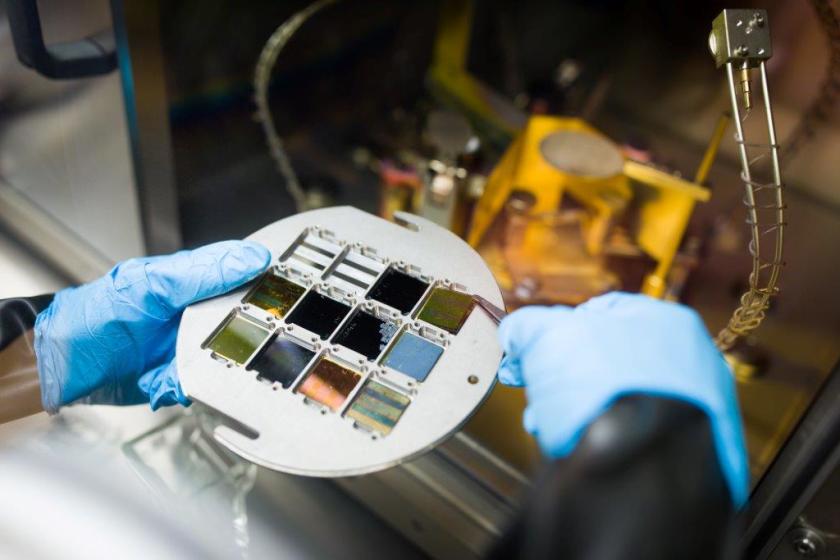Perovskite-silicon solar cell research collaboration hits 25.2% efficiency

Perovskite-based tandem solar cells can achieve now efficiencies better than 25%. © HZB
A 1 cm2 perovskite silicon tandem solar cell achieves an independently certified efficiency of 25.2 %. This was presented this week at an international conference in Hawaii, USA. The cell was developed jointly by HZB, Oxford University and Oxford PV - The Perovskite CompanyTM.
"Perovskite-based tandem solar cells can use light particularly efficiently and therefore offer the opportunity to achieve even higher efficiencies. That is why we have significantly expanded our expertise with the new Helmholtz innovation laboratory HySPRINT," says Prof. Dr. Rutger Schlatmann, Director of the Competence Center Thin Film and Nanotechnology for Photovoltaics Berlin (PVcomB) at HZB. "In our cooperation with Oxford PV, we aim to further optimize perovskite silicon tandem cells, demonstrate their scalability and facilitate their integration into large-area solar modules. For this new result we have optimized our high-efficiency silicon heterojunction bottom cell and developed an optical adaptation to the top cell using a very specific SiOx intermediate layer".
At the World Conference on Photovoltaic Energy Conversion, WCPEC-7 in Waikoloa, Hawaii, tandem solar cells involving perovskites were an important topic: two records have been presented with 25.2% certified efficiency: one from the group of Prof. Christophe Ballif at EPFL/CSEM and one from the consortium HZB/OxfordPV/Oxford University, presented by HZB scientist Dr. Bernd Stannowski. The third one, with 25.0% certified efficiency is a tandem cell developed by an HZB team headed by Dr. Steve Albrecht.
Oxford PV was established in 2010 and has had a close working relationship with Professor Snaith’s research group at the University of Oxford. In January 2018, Oxford PV announced its collaboration with HZB, the leading German research centre focused on energy materials research.
Press Release by Oxford PV
More Information on PVcomB at HZB
More Information on HySPRINT at HZB
More Information on the group Photovoltaics and Optoelectronics at University of Oxford
https://www.helmholtz-berlin.de/pubbin/news_seite?nid=14839;sprache=en
- Copy link
-
Green hydrogen: MXenes shows talent as catalyst for oxygen evolution
The MXene class of materials has many talents. An international team led by HZB chemist Michelle Browne has now demonstrated that MXenes, properly functionalised, are excellent catalysts for the oxygen evolution reaction in electrolytic water splitting. They are more stable and efficient than the best metal oxide catalysts currently available. The team is now extensively characterising these MXene catalysts for water splitting at the Berlin X-ray source BESSY II and Soleil Synchrotron in France.
-
SpinMagIC: 'EPR on a chip' ensures quality of olive oil and beer
The first sign of spoilage in many food products is the formation of free radicals, which reduces the shelf-life and the overall quality of the food. Until now, the detection of these molecules has been very costly for the food companies. Researchers at HZB and the University of Stuttgart have developed a portable, small and inexpensive 'EPR on a chip' sensor that can detect free radicals even at very low concentrations. They are now working to set up a spin-off company, supported by the EXIST research transfer programme of the German Federal Ministry of Economics and Climate Protection. The EPRoC sensor will initially be used in the production of olive oil and beer to ensure the quality of these products.
-
Review on ocular particle therapy (OPT) by international experts
A team of leading experts in medical physics, physics and radiotherapy, including HZB physicist Prof. Andrea Denker and Charité medical physicist Dr Jens Heufelder, has published a review article on ocular particle therapy. The article appeared in the Red Journal, one of the most prestigious journals in the field. It outlines the special features of this form of eye therapy, explains the state of the art and current research priorities, provides recommendations for the delivery of radiotherapy and gives an outlook on future developments.
